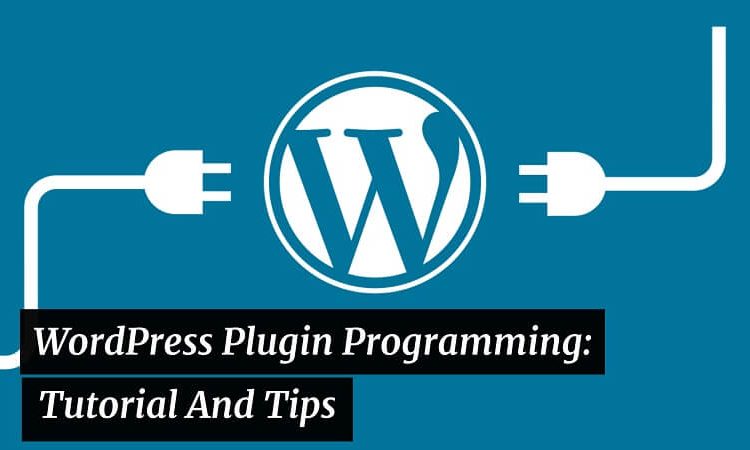WordPress Plugin Programming: Tutorial And Tips

Hello everyone, today in this article, we are going to discuss WordPress plugin programming: tutorial and tips. So keep reading.
WordPress is one of the most popular platforms for creating web content. Currently, more than 455 million websites use WordPress, with more than 400 million people viewing more than 15 billion pages of content that are built on WordPress platforms. Each month, more than 41 million blog posts are published through WordPress blogging platforms. If you have been using WordPress for any length of time, you are likely familiar with the importance and power of plugins. They help to turn plain websites into fully developed online experiences, but there is a massive difference between using a plugin and building your own plugins.
The good news is that creating your own plugin is easier than you’d expect. Once you know how plugins work and what they do, you’ll be prepared to start building your own plugins.
If you’re not sure where to begin when creating a WordPress plugin, we have you covered. In this article, we’ll take a look at WordPress plugin development with a tutorial and some tips and strategies for plugin development.
So where should you begin? Start here:
Table of Contents:
1. Know What WordPress Plugins Do
2. Have A Basic Knowledge Of Coding
3. Choose A Name For Your Plugin
4. Develop Your Plugin Folder And PHP File
5. Add Your File Header
6. Program The Functions Of Your Plugin
7. Compress The Plugin Folder
8. Activate The Plugin
#1. Know What WordPress Plugins Do.
WordPress plugins are a powerful way to build out the functionality of a website without the need to edit code. There are thousands of pre-made plugins available for WordPress, but you may find that developing your own plugin is a better choice because it will allow you to customize the functionality of the plugin beyond what is currently available in the marketplace. A WordPress plugin is a function written in the PHP programming language composed of actions, filters, shortcodes, and widgets.
#2. Have A Basic Knowledge Of Coding.

In order to effectively program a WordPress plugin, you’ll need to know the basics of PHP coding. While you don’t need to be an expert in coding to succeed in plugin development, it helps to have a basic understanding not just of PHP but also CSS and HTML. There are many tutorials online that can get you up to speed.
#3. Choose A Name For Your Plugin.
The first step in plugin development is selecting your plugin’s name, which should both relate to the plugin’s function and serve as a unique identifier. You’ll want to conduct a search to make sure that the name isn’t being used by another plugin. The name of the plugin will become the name of the plugin’s folder and a PHP file.
#4. Develop Your Plugin Folder And PHP File.
Any plugin needs to have a location where it will live. Create a plugin folder within your WordPress build by going to the wp-content/plugins folder of your WordPress installation and creating a folder with the name of your plugin. Create a PHP file within the folder that shares the same name as the file. In both cases, use hyphens instead of spaces when there are multiple words. Complex plugins may require more than one PHP file.
#5. Add Your File Header.
Your next step is to add your file header. This will consist of a block comment with the metadata about your plugin. Your header should look something like this, with your plugin’s specific information substituted for the generic here. You may make the plugin longer or shorter, but at a minimum, it must include the plugin’s name.
/**
* Plugin Name: Your Plugin’s Name
* Plugin URI: http://yourwebsite.com
* Description: Add a quick description here of your plugin’s function.
* Version: 1.0.0
* Author: Your Name
* Author URI: http://yourwebsite.com
* License: GPL2
*/
#6. Program The Functions Of Your Plugin.
At this point, you have the framework of a plugin but not the functionality of one. To create functionality, you will need to establish the action that your plugin performs, either through WordPress’s preformatted functions or one of your own. You will need to establish the filters that determine how your content will display to others. You will need to develop the shortcodes that allow you to present custom functionality for site users. Shortcodes allow plugins to be added quickly. Widgets also provide an easy way to add your plugin to a webpage.
#7. Compress The Plugin Folder
Once you add a PHP file to the plugins directory, your plugin automatically is added to your website, but you will likely have multiple files by the time you are done, so you will need to compress them by zipping all of the files for your plugin into a single Zip file. Typically, you right-click and select “compress.”
#8. Activate The Plugin
Now comes the moment of truth: Go to your plugins directory and upload your folder, or select your PHP or ZIP file if it is already in the plugins directory. Add it to your site and begin using the functionality! You’ll want to test it out before you put it out on the open web to make sure it works correctly.
If you are looking to develop a plugin as part of college coursework or need help programming your coding homework assignments, it’s easy to pay a service like Assignment Core for expert assistance. Students often benefit from expert help when it comes to programming and coding. Online services can form an important part of students’ academic development by helping them to see how an expert would approach their most challenging coding problems so they can develop the most effective plugins and programming possible.
So that’s all from this blog. Thank you for reading this article and visiting our site. I hope you liked this article on WordPress plugin programming: tutorial and tips.
